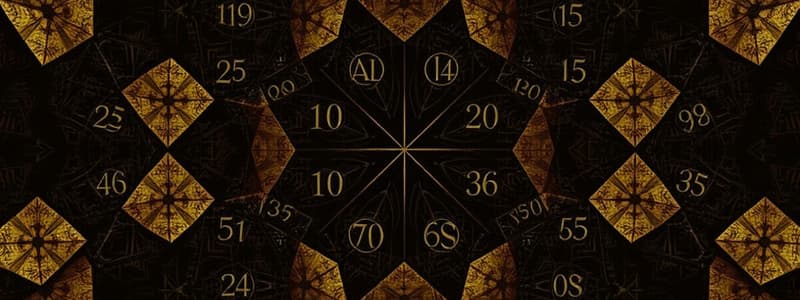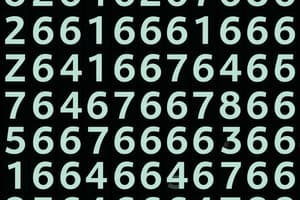Podcast
Questions and Answers
What type of pattern involves sequences of numbers that follow a specific rule?
What type of pattern involves sequences of numbers that follow a specific rule?
- Geometric Patterns
- Visual Patterns
- Numerical Patterns (correct)
- Algebraic Patterns
Which application of patterns is NOT mentioned in the context of mathematics?
Which application of patterns is NOT mentioned in the context of mathematics?
- Nature
- Social Media Trends (correct)
- Art and Design
- Technology
How do patterns facilitate predictions based on observed regularities?
How do patterns facilitate predictions based on observed regularities?
- They hinder critical thinking and reasoning.
- They provide randomness in data analysis.
- They establish relationships that can be modeled. (correct)
- They simplify complex statistical calculations.
What is a significant concept related to patterns in mathematics?
What is a significant concept related to patterns in mathematics?
Which of the following best describes the role of patterns in early mathematics education?
Which of the following best describes the role of patterns in early mathematics education?
What is a fractal?
What is a fractal?
Which of the following is NOT a type of pattern discussed?
Which of the following is NOT a type of pattern discussed?
Pattern recognition is important in which of the following fields?
Pattern recognition is important in which of the following fields?
Flashcards are hidden until you start studying
Study Notes
Pattern and Formation in Mathematics
-
Definition of Patterns:
- A pattern is a repeated or recurring arrangement of numbers, shapes, or other elements.
- Patterns can be found in nature, art, architecture, and daily life.
-
Types of Patterns:
- Numerical Patterns: Sequences of numbers that follow a specific rule (e.g., arithmetic sequences, geometric sequences).
- Geometric Patterns: Arrangements of shapes that repeat or follow a specific design (e.g., tessellations).
- Algebraic Patterns: Relationships expressed using algebraic symbols, often used to represent real-world situations.
-
Importance of Patterns:
- Help develop critical thinking and problem-solving skills.
- Serve as foundational concepts in mathematics, leading to advanced topics like calculus and statistics.
- Facilitate predictions based on observed regularities.
-
Pattern Recognition:
- The ability to identify and predict patterns is crucial in mathematics and many scientific fields.
- Used in various applications, including data analysis, computer science, and artificial intelligence.
-
Formation of Patterns:
- Involves creating new patterns based on existing rules or sequences.
- Often explored through mathematical reasoning and logic.
- Can be represented visually, numerically, or algebraically.
-
Applications of Patterns:
- Art and Design: Use of symmetry and repetition in visual arts.
- Nature: Observable patterns in growth, such as the Fibonacci sequence in plants.
- Technology: Algorithms in computer science often rely on patterns for efficiency.
-
Teaching Patterns:
- Important for early mathematics education to help students recognize and create patterns.
- Engaging activities can enhance understanding and retention.
-
Mathematical Concepts Related to Patterns:
- Functions: Mathematical relationships that can be observed as patterns.
- Statistics: Patterns in data that help in analyzing trends and making predictions.
- Fractals: Complex patterns that are self-similar across different scales.
-
Exploration and Discovery:
- Encourages students and researchers to explore new mathematical concepts and relationships.
- Promotes innovation in problem-solving approaches and methodologies.
Definition of Patterns
- A pattern is a repeated arrangement of numbers, shapes, or other elements.
- Patterns are prevalent in nature, art, architecture, and everyday experiences.
Types of Patterns
- Numerical Patterns: Involves sequences of numbers governed by specific rules (e.g., arithmetic sequences, geometric sequences).
- Geometric Patterns: Involves arrangements of shapes that repeat or follow set designs (e.g., tessellations).
- Algebraic Patterns: Represent relationships using algebraic symbols, applicable to real-world contexts.
Importance of Patterns
- Develop critical thinking and problem-solving capabilities in learners.
- Serve as foundational mathematics concepts, paving the way for advanced studies in areas like calculus and statistics.
- Enable predictions based on recognized regularities.
Pattern Recognition
- Crucial skill in mathematics and sciences, allowing for the identification and prediction of patterns.
- Found in various fields, including data analysis, computer science, and artificial intelligence.
Formation of Patterns
- Involves the creation of new patterns derived from existing rules or sequences.
- Explored through mathematical reasoning and logic, represented visually, numerically, or algebraically.
Applications of Patterns
- Art and Design: Symmetry and repetition enhance visual art and design.
- Nature: Patterns in growth, such as the Fibonacci sequence in plants, exemplify natural phenomena.
- Technology: Many algorithms in computer science utilize patterns to improve efficiency.
Teaching Patterns
- Recognition and creation of patterns is vital in early mathematics education.
- Engaging activities enhance students' understanding and memory retention of patterns.
Mathematical Concepts Related to Patterns
- Functions: Mathematical relationships observable as patterns.
- Statistics: Analyzes data patterns which aid in trend analysis and prediction.
- Fractals: Complex self-similar patterns that appear at various scales.
Exploration and Discovery
- Encourages both students and researchers to investigate new mathematical ideas and relationships.
- Fosters innovative problem-solving strategies and methodologies.
Studying That Suits You
Use AI to generate personalized quizzes and flashcards to suit your learning preferences.




